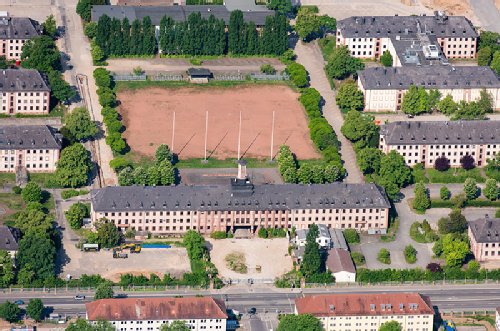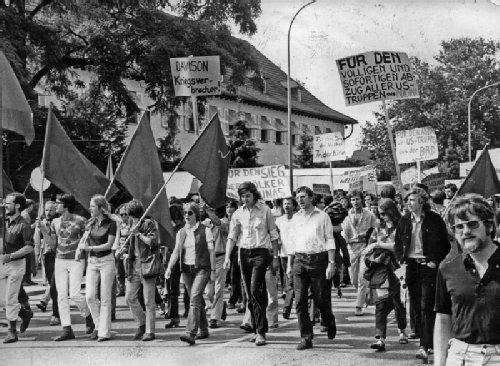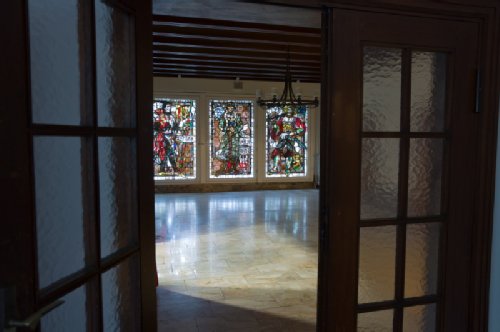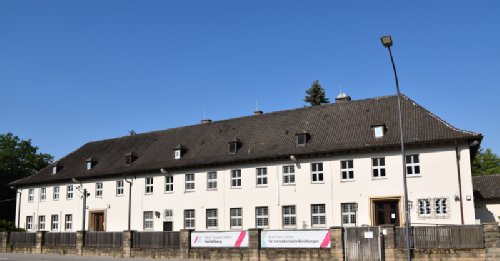Uwe Wenzel Ph.D
Mark Twain Center for Transatlantic relations
The past and future of German-American relations in Heidelberg
The Mark Twain Center for Transatlantic Relations (MTC) was established on the initiative of the City of Heidelberg, following the withdrawal of the U.S. military. According to the operating concept adopted in 2018, the MTC has a twofold mission. First, to develop a multimedia exhibition to commemorate the coexistence of American and German citizens that shaped Heidelberg society during the postwar period. Second, to initiate a critical dialogue around issues of importance for the future of transatlantic relations. It is intended that the work should involve a range of academic collaborations and cultural activities. The City of Heidelberg, with support from German federal government programs, has invested around 5 million euro to date toward the fulfillment of the MTC’s mission.
Background
Heidelberg’s history vividly illustrates the fundamental changes in German-American relations over the course of the 20th century. The two communities succeeded in navigating a path, albeit one often beset by conflict, from wartime enemies to partners in a values-based society. A central role in this was played by the presence in Heidelberg of important U.S. Army installations. Since 1945, over 20 million U.S. Americans have served as military or civilian personnel in the American armed forces in Europe, with Germany always the main country where they were stationed. From 1948 onwards, the U.S. Army’s Heidelberg base was the location of high-level military headquarters. As a result, hundreds of thousands of military personnel lived with their families in Heidelberg and the wider Rhine-Neckar region, often for long periods of time. Over 25,000 U.S. citizens have been born at Heidelberg’s U.S. military hospital since the end of the war.

The presence of the U.S. armed forces was also very significant for the people of Heidelberg. Tens of thousands of them were employed by the American military, largely in civilian roles, and it wasn’t unusual for people to spend their whole working lives at Campbell Barracks or other U.S. military installations around Heidelberg. Aside from the connections made in their professional lives, over the decades many bridges were built between the German and American communities, supported by an active culture of clubs and societies, encounters through the city’s clubbing scene and, last but not least, the many binational marriages that took place.
However, civilian coexistence in Heidelberg was never without conflict. In the beginning, the requisition of living space and the construction of residential developments for the U.S. Army had a detrimental effect on the relationship between the townspeople and the occupying forces. Later, global political events, such as the U.S. interventions in South-East Asia and the debate during the 1980s about troop deployments, had a long-term impact on relations between Germans and Americans in the city.

A historic location with global political significance
The withdrawal of the last U.S. forces from Heidelberg on September 6, 2013 marked a new phase in the relationship between the German and American people. The City of Heidelberg had begun early on to make plans for the purchase of the land used by the U.S. Army, and for the transformation of an area of at least 440 acres (180 hectares) for civilian purposes. Unlike at other U.S. military installations in Germany similarly affected by the Army’s withdrawal, in Heidelberg the intention was always to establish a living memorial where the past and future of transatlantic relations could be researched and explored. The opportunity to realize this project came when it was included in the funding framework for the German federal government’s National Urban Development Projects program in 2016. As part of the restructuring, renovation and conversion of the historic barracks site, the plan was to develop the former command building as a cultural and academic institution. In 2018 and 2019 the building underwent the necessary technical refurbishment and was made accessible for people with disabilities.
The MTC is taking shape in the U.S. Army’s former Heidelberg headquarters in Römerstrasse. The building, named after former commander General Geoffrey Keyes, provides a striking illustration of the changes in German-American relations. Built in 1937 during the remilitarization of Germany, the building initially served as the officers’ mess for the Wehrmacht (armed forces) alongside the likewise newly constructed ‘Großdeutschlandkaserne’ (Greater Germany Barracks). With the occupation of Heidelberg by U.S. forces on March 30, 1945, the barracks became part of the headquarters of the U.S. Seventh Army. The Keyes Building became the headquarters of the U.S. commander-in-chief and chief of staff, with the former casino ballroom serving as a conference room. From Heidelberg, the U.S. Army units stationed in Europe directed and administered their facilities and activities, and developed strategic deployment plans. The realignment of U.S. military strategy in the early 2000s also marked a turning point for Heidelberg, and the site was eventually closed after 68 years of U.S. military presence in the city.

Mission and objectives
The activities of the Mark Twain Center are intended to keep the memory of the American presence in Heidelberg alive and to promote transatlantic dialogue. These activities include exploring and researching the history of German-American relations, organizing cultural events and educational opportunities, and facilitating discussion of important issues for transatlantic relations going forward. The MTC should also be a place of exchange and collaboration between specialist institutions and organizations involved in German-American cooperation at the local, national and international levels.
The MTC sees itself as a vibrant space for commemoration, providing regular opportunities for interested parties to be actively involved, and encouraging participation at different levels. An initial focus of the work is to set up a multimedia permanent exhibition on transatlantic relations from a specifically Heidelberg perspective. The exhibition will be displayed across an area of around 14,000 square feet (1,300 m²), and will include the rooms at the MTC that are of particular historical significance (e.g. the Commanding General’s office and the Keyes Building Conference Room). The planned multimedia installations will transform these spaces into the centerpiece of the MTC’s educational and creative activities.

Permanent exhibition on transatlantic relations
The permanent exhibition is intended to facilitate multiperspectivity and provide space for German-American history to be questioned and explored. The links between the German and American people have undergone constant transformation and so resist simplistic historical classification or dominant viewpoints. Visitors will be able to experience how friend and foe managed to coexist during the post-war years, as well as the way tensions and conflicts developed at local level in the period that followed, and how these conflicts were resolved (or not). The example of Heidelberg illustrates very clearly how relationships at the local level must always be seen in the context of national and international developments.
The exhibition is intended to give equal consideration to social, political, economic and military aspects of German-American relations. Since the historical links between Heidelberg and the U.S.A. stretch back to before the founding of the United States and had a significant influence on post-war developments, they also form an important focus. Key elements here are the mass emigration of Germans from the Palatinate region, the extraordinary role played by Germans in the American War of Independence and the particular appeal of Heidelberg for U.S. students and tourists in the 19th and early 20th centuries.
Following the U.S. Army’s takeover of Heidelberg without force in March 1945, its units began to make use of former Wehrmacht sites. Amazingly, historical traces of the former ‘Großdeutschlandkaserne’ and, in particular, potent examples of Nazi-era propaganda art in the former officers’ casino were left virtually untouched by the U.S. military leadership in Heidelberg. This very specific approach to ‘dealing with the past’ provides a bridge to the portrayal of the Heidelberg garrison’s military history. A model of the town shows the various U.S. Army installations large and small, other exhibits lead to the clubs and civilian institutions that for decades were the sites of encounters between Germans and Americans.
The other exhibition spaces will seek to convey the wide variety of tasks carried out by the military leadership, and the living and working conditions within a garrison. Personal portraits trace the lives of individual soldiers, charting their careers, and showing the long-term effects of discrimination and racism on the career prospects of female military personnel and members of ethnic minorities in the armed forces. Other key parts of the permanent exhibition focus on the civilian side of German and American coexistence in Heidelberg. The renaissance of democracy in Heidelberg is closely linked to the American presence in the city, and this forms an important feature of the permanent exhibition. Similarly significant are the wide-ranging forms of interaction that took place through the city’s ever-changing music scene, and through sporting and other organized activities.
A Heidelberg perspective on global history – history told through personal stories
The overall concept of the Mark Twain Center’s permanent exhibition is based on the principle of biographical exploration and learning. The intention is to illustrate and explain developments over time through the biographies of 40 selected individuals whose ‘stories’ will be presented in the form of film portrayals, complemented by a number of historical biopics. This will be accompanied by further information and explanation of the historical context.
An innovative approach has been taken to the presentation of the biographies and other exhibition content. When they enter the exhibition visitors will be given a tablet that serves as a digital dossier. Using bluetooth, in each room a file is provided containing biographies, texts, documents, films and photos that relate to the installations in that space. Visitors can therefore largely create their own tour. The tablet also provides opportunities for interactive and game elements. The technology-based concept means that the exhibition can be continuously expanded, and in the medium and long term new discoveries can be incorporated and new personal testimonies added.
The basic concept for the exhibition content is now complete and the permanent exhibition is therefore expected to open in April 2022. In the coming months additional people who will share their testimonies will be sought in the U.S.A. A selection process is currently underway to find a media production company to record testimonies in June and July of this year. After this, the further development of the exhibition is envisaged as an open-ended and participatory process. The technical set-up means that we can easily add more content, for example when new individuals are found who have interesting stories to share.
Slightly updated version, published in "Heidelberg-Jahrbuch zur Geschichte der Stadt 2021", pages 239-245, published by the Heidelberger Geschichtsverein e.V.

